|
|
|
|||
|
|
||||
|
|
||||
| The Smoky Addiction | ||||
|
|
HOME | SITE MAP | FORUM | CONTACT |
|
||
|
ABOUT | MOTORS | MODELS | ARCHIVE | HISTORY | STORE | FAQ | LINKS
|
|
|
|
|
|
|||||||||||||||||||||||||||||||||||||||||||||||||||||||||
 The Smoky Addiction 3
(March 2005)
The Smoky Addiction 3
(March 2005)by Roger Simmonds Reprinted from SAM 35 Speaks, March 2005 (with corrections) More Models in Profile It’s always comforting to hear from fellow addicts, especially when their confessions relate to current obsessions. Eric Bulmer, whose twin Rapier L1 powered all-sheet MiG 9 was discussed some time ago, emailed: |
|
|||||||||||||||||||||||||||||||||||||||||||||||||||||||||
|
“I made an He 162 profile job of about 9" span. It hand-glided very well, straight & fast. On catapult (no Rapier) it did similarly but as the speed dropped off it just tumbled, most amusing! On lighting the Rapier L4 (yes, L4) and catapulting it once the fizzing started, it was most spectacular and roared off into The Blue leaving an impressive smoke trail – one of the childish joys of Rapiers! Flitehook couldn’t supply any more, so I re-jigged it for L2 LT power. This time off the catapult and with the Rapier smoking it flew just as well, circling at what seemed great height, BUT over the dreaded Black Lagoon (one of the hazards of our BAe Brough airfield) and, as it was so small, we lost sight of it and can only assume it met a watery grave. But it was worth it! The MiG 9 is still flying when it is calm (not very often in E Yorks, believe me) but the last time I took it out both fuses just burned out without igniting the Rapiers. On investigation I found that the hole needed drilling out deeper with a Thanks Eric, these ‘Silhoujettes’ (Skyleada’s very nice pun) are a lot of fun. ‘Core boring’ is definitely necessary for reliable L2 LT ignition: I recommend a 1mm screwdriver, as drills, though certainly very effective, can all too easily damage the orifice. Rapier fuses are longer than necessary, and since half is usually sufficient to ‘do the job’, if one breaks them in two a supply of half fuses (which can be kept in a small tin) quickly accumulates. I haven’t tried Jetex wick with Rapiers: it should work OK, but do remove the copper core after ignition. It is also reassuring to hear from prodigal modellers returning to the delights of rocketeering after a number of years. Steve Bage, (who lives even Further North than Eric) confides: |

- airmodeller.tripod.com

- Galería de Maquetas de los Foristas
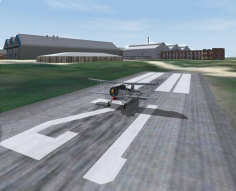
- Visual Fight Photographic Scenery
|
|||||||||||||||||||||||||||||||||||||||||||||||||||||||||
|
“I rediscovered Jetex/Rapier models [on the Internet] accidentally. My original Jetex experience about 30 years ago was somewhat disappointing, as I just did not have the perseverance (or skill) required, and my memories consist mostly of lots of fiddling around with bits of gauze and fuse and futile attempts to get the thing burning. I’ve certainly found Rapier motors much easier than Jetex. I like designing and building as much as flying and wanted to try a type not modelled before (as far as I know), hence the Yak-25. Twin engines excluded, it’s got a pretty good layout with nice proportions and plenty of wing area. I knocked up a 12", 25 grams, all-sheet version for 2 x L1 power to test the out the design, especially the viability of anhedral. If it goes OK it would be a nice model in its own right for those who like flying more than building.” Steve’s ‘knocked up’ model exemplifies a debate we have touched on before: the efficacy of profile prototypes to investigate the layout, angles of incidence etc. of a more elaborate model. On the flying field Steve found, like Eric, that the motors needed drilling out before he could get them to ignite reliably, but the results were memorable when he did: “After launching into a stiff breeze the model climbed almost vertically at a high rate of knots to quite some altitude and then started a series of high speed loops, all the time moving rapidly downwind and gaining height. The glide was quite steep; a good thing as the model was already some distance away. I ought to have called it a day, as the wind was increasing, but the sight of two smoke trails is addictive! I added a bit of 'Blu-Tack' to try to calm the loops down a bit, but I must have overdone (or underdone) it, because it still tried to loop, and hit the deck before pulling out of the first one … both nacelles sheared off, one went so far I could not find it in the long grass. Being all-sheet it can be repaired without much trouble. All in all, a pretty successful first try.” Steve concludes from his experiments: 1) A twelve-inch span 25g model is grossly overpowered by two L1’s, but is lot of fun. 2) Thrust variation of motors and one quitting before the other is not a major issue, but take a lot of care over motor preparation. 3) Scale anhedral on the Yak 25 gives marginal stability, and it would be best to go for a flat wing on a larger model. 4) The temptation to launch if only one motor ignites is irresistible … but don’t do it! So in this instance building a profile prototype was a successful and reassuring exercise; Steve, being a dab hand at CAD, has already generated plans for his built-up model, which, at a shade over 270 mm span, is for twin L2 LT power. He originally contemplated L2 HPs, but observes, “these have quite a short duration, perhaps not so well suited to a twin where a few seconds burn may be lost waiting for both motors to ignite.” This is of course true, but then the L2 LT is a little more tricky to get started (see Eric’s comments). |
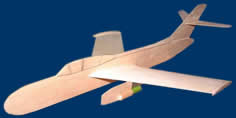 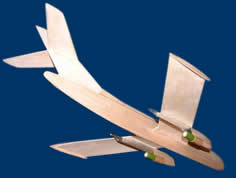
- Steve Bage
|
|||||||||||||||||||||||||||||||||||||||||||||||||||||||||
|
|
|
|||
|
Continuing our theme of profile models as experiments or ‘proofs of concept’, Peter Tolhurst has built another ‘Speedjet’ to replace the one he lost in a thermal over Old Warden. I suppose this unfortunate event could be seen as retribution for not flying the Speedjet in a truly authentic manner: that is, horizontally at 100 mph, according to the 1950 MAN article! This time Peter has taken a photo of his bright red model before test flying (see right). The Rapier L1 is where the Sparklets bulb sat in the 1950 original. Peter writes: “I scaled up the plan in Tony Brookes 1985 'Green Bottles' using a green bottle as the basic dimension (I assumed Arch Hall used a standard Sparklets size). The span is 7.5" and the length about 12". I’ve used the angles depicted in the original plan rather than the dimensions quoted, as the 4" dihedral shown under each tip appears a bit much for 7.5" span; either the plan contained a typo or the bottle is a larger than standard. Does anyone in Samland have a copy of the April 1950 MAN to confirm the size? Anyway, I’m ready and raring to go at MW or OW, hopefully without losing it this time!” I hope Peter remembers to put his name and address on this one. Incidentally, my (full size) copy of the original plan indicates ¾" under each wing tip, and a span of just 7". |

- Peter Tolhurst
|
|||
Many will readily concur with Steve’s comments about all-sheet models being ‘nice in their own right’. They can also be a demonstration of creative modelling ‘fine art’, requiring real woodworking skills, and a way of getting some very exotic shapes into the sky. As a nice example of this, André Bird exhibited an ‘Apparition’ at Impington in October.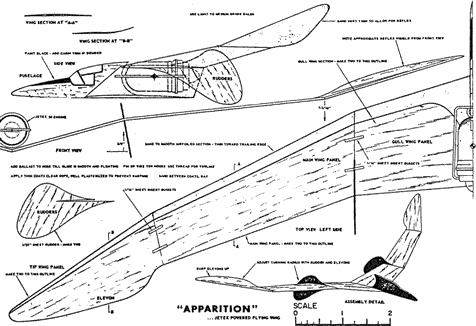
- PSST Off Sheet
This is indubitably a ‘real model in its own right’, akin to an abstract wooden sculpture, and it attracted much favourable comment for its wood selection and finish. The original (Jetex 50 powered) Apparition was, I believe, first published in the US in the fifties. The plan [above] is from Roger Walthen’s PSST Off’ Sheet. Unfortunately it gives neither the date of publication nor the designer’s name.  Rocket-plane Pre-History The new column gives me an excuse to revisit topics in the light of new material that my teams of assiduous researchers have uncovered. We looked briefly at the experiments of an L F Hutcheon in the  |
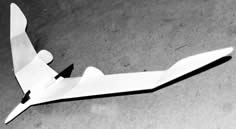
- André Bird
|
|||
|
Hutcheon reported that the initial excursions had been encouraging: though his best flight was a mere 20 yards at four feet, it only descended “because of switchbacking due to over elevation”, and he was of the firm belief that when fitted with a more powerful rocket and correctly elevated it would traverse a distance of “300 yards”. Johnson, who had had some success with a more conventional model, was less sanguine. We can now, thanks to Ian, assess the potential of Hutcheon’s ‘rocket-plane’ for ourselves. I’m afraid the ‘plan’ is no more than a guide to any recreation of a model that appears to have some interesting features, viz. a canard layout, an elevator with ‘bent down tips’ and, thoughtfully, a ‘protector’ at the front. The Missing Lynx and the Latter Days at Jetex |
|
|||
|
Chris Strachan sent me a copy of ‘Trade Notes’, Aeromodeller (AM) October 1960, which included a review of the ‘‘unique and attractive” Lynx. It makes occasionally bizarre reading: “Do not be misled by the words ‘plastic’ and ‘pre-formed’ ”, it begins, “as it is a lengthy build, definitely not a kit for the ‘raw beginner’ … it would be most suited to a modeller with a little experience … perhaps a bedridden modeller in hospital [!] who has many hours to occupy, but does not want the mess or inconvenience of cutting out and tissue covering.” I can see that going down a real bundle in today’s wards, where one would be lucky to have time to assemble even the simplest ARTF. The review continued, “The silver covering material did not give as smooth a finish a finish as we [sic] would hope for, however much pulling and smoothing is done at the LE and TE.’” Perhaps Matron could have lent them a hair-dryer. Tissue covering is recommended for “the flying enthusiast”, and a “hefty chuck” was most definitely required for launch. Strangely, though typically, there was no further assessment of the model’s flying potential. The Lynx does have a special place in Jetex history quite apart from its novel use of plastics, as it was Bert Judge’s last ‘Tailored’ design. I have long wanted an example, but haven’t (as yet) tracked one down – they are obviously as rare as vacant hospital beds. Not all is lost, however. First, Terry Kidd thinks the plastic fuselage shells will be easier to make than the wooden skins of earlier tailored models. Second, the attractive aluminised covering (thin acetate, apparently, not Mylar) with its simulated rivets would have been difficult to replicate, but, flying enthusiasts that we are, we have AM’s authority to substitute tissue. |
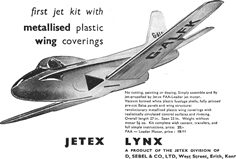
- Aeromodeller, Oct. 1960
|
|||
|
It did make for a heavy model anyway: the AM review quoted an all up weight of six ounces, whereas the instructions specify “5 oz”. No wonder it needed a hefty chuck. Terry writes about those fuselage halves: “Plastic makes good sense for Jetex models, as it can be very thin, and will be approved of by those who see stringers on jet planes as inappropriate. Last time I was in a school CDT dept I was very impressed by the vacuum machine, which was a nice big perforated bed about 24" x 12", easily large enough replicate a Lynx. Once the tool was made you could knock 'em out by the dozen. I think I'd try a balsa mould and make left and right halves. It's easy if you don't mind that exterior flange for joining. I'd start with the thinnest gauge plastic I can find and see how well it forms around the tool. If it draws around the curves without pulling into holes, you're on to a winner. Then add a bit of balsa or carbon fibre [expletive deleted] for strength where needed. Obviously the curvature adds to the strength and Bert Judge and co would have exploited that when they designed the Lynx.” All this makes very good sense, though the CDT stuff is a little beyond me. One problem, however, remains: though the plan gives details of the (built-up) wings and tail, there are no fuselage profiles, so we still need access to a kit. |
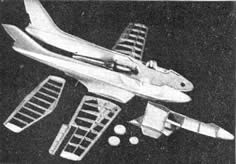
- Aeromodeller, Oct. 1960
|
|||
|
Staying with elusive Tailored models, here is a photo of Ginger Cooper, one of the team at Wilmot Mansour in the early fifties, holding one of Bert Judge’s Tailored Javelins. Peter Cock is in the background. I hope drawings for this failed project will come to light one day. I had a most gracious letter from Ron Pascoe that included this reminiscence of his days at Jetex/Sebel, when Bert and Joe Mansour were striving to develop a new pellet formulation that didn’t infringe ICI’s patents: “The problem was that the new pellets were burning at a much higher temperature and melting the aluminium casings. This was resolved by Joe Mansour and Bert Judge, but it was a bit hit and miss at first getting the right combination of ingredients. A small test rig was installed in the Drawing Office and everybody was alerted to stand back in case things went wrong, as they occasionally did! Bert had to design new [steel] cases for the motors with a very thin wall. These used to glow cherry red in test firings, which was quite something to see. Eventually they got things working and relaunched with products all made in-house. Bert was quite a knowledgeable chemist by the time he had finished.” This is another valuable insight into what was a critical period for the survival of Jetex. The “cherry red glow”, incidentally, implies a temperature between 550 and 575°C, quite impractical for an aluminium alloy, so the development of the new 50C and PAA-Loader motors was a matter of some urgency. These were reliable and practical power plants, though I was most upset when my brand new golden 50C became black on its first firing. Nobody had warned me. The Atom 35 retained an aluminium alloy case, which remained untarnished throughout its working life. I’m not sure how this withstood the new fuel’s high combustion temperatures: perhaps its small size and limited 7-9 sec. duration meant the case remained comparatively cool. Ron remained at Jetex for some years, and designed an ARTF glider, the Sebel ‘Theron’ (note Bert’s terrible, if forgivable, pun on his colleague’s name). This product was also notable in having, like the Lynx, a plastic vac-formed fuselage. X-43 Revisited |

- Mike Ingram
|
|||
|
Whilst assembling the composite 3-view of the X-43 Scramjet featured in January’s Smoky Addiction, I couldn’t help thinking I had seen this shape, or something very like it, before. After some searching I unearthed Paul Del Gatto’s ‘Satellite Racer’ for Jetex 50 (right), which was marketed by Telasco in the States in 1957. Ok, so it’s a car, and RTP, but the resemblance to NASA’s hypersonic test bed is uncanny. With a pair of small wings I wouldn’t be at all surprised if it took off! Truly, there is nothing new under the sun… Skyrockets |
 |
|||
|
The (Mach 2) Douglas D-5588-2 Skyrocket was, like the Hawker Hunter that resembled it in many ways, a most attractive prototype. Steve Bage wants to build one and wondered what is available. Well, to start with, there were a couple of interesting fifties’ kits: Carl Goldberg’s ‘Superform’ design for Jetex or catapult, a ‘deluxe’ member of Top Flite’s ‘Jigtime’ series (see right, also (Jet)X Files, August ’04); and the even more sophisticated tailored Wilmot Mansour model, that was, somewhat paradoxically, one of their ‘Mach One’ stable. The former model had a span of 12" and the motor, if any, was external; in the latter, air from the intakes and the unglazed cockpit fed an enclosed 50B and augmenter tube. Original examples of both do turn up from time to time (unlike the Lynx), but they are now too precious to build or fly. Paul Bradley offers plans for some Jigtime Jets on his excellent website (parmodels.com) for example the NA F-86, Cutlass and MiG15, but not (yet) the Superform Skyrocket. I have drawings for the WM ‘Tailored’ Skyrocket [right], but it would be a demanding model even without its ‘stressed skin’ fuselage and enclosed motor: its length of 11¾" and span of just 7½" equate to a wing area of around 15 sq. in and a wing loading of 10-11 oz/sq. ft. Richard Crossley’s contemporary design is really a much more practicable proposition. Samizdat copies of the plan have been circulating amongst aficionados of Richard’s creations for some time; with a length of 15" and a span of just over 10", it has twice the wing area of the ‘Tailored’ Skyrocket and a less daunting wing loading. Pete Smart and I have built versions with scale anhedral, which enhances its looks no end (see (Jet)X Files, August ’04), and both fly very well at high speed with L2s of various ratings. Adam Jenik of the Czech Republic built the version on the right. As can be seen, it is a nice ‘traditional build’, similar in concept to Bill Dean’s KK MiG 15. Highly recommended. If one is unhappy with the compromise of a modern, though ‘retro,’ design, and wanted a Skyrocket that is both antique and a ‘traditional build’, there is at least one viable option: Joseph H Wherry’s plan for the earliest prototype, published in 1950. This RTP model, originally for CO2 or ‘whip’ power, was quite large, 19½" long for a span of a little under 12", so reduction for a Rapier L2 is necessary. One might also be tempted to modify the cockpit, do away with the undercarriage and add wing spars and balsa sheeting around the nose. But the position of the CO2 bulb (its nozzle is just ahead of bulkhead 6) is reasonable for a rocket motor, and a trough could easily be incorporated back to bulkhead 8. I see no reason why, given the directional and lateral stability of Richard’s design, this one shouldn’t go free flight very well indeed. |
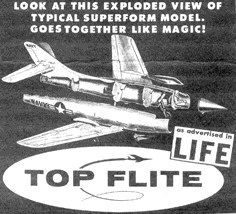 
- Allen Hunt
 Wilmot Mansour ‘Mach One Tailored’ Skyrocket (1954). Note all-sheet flying surfaces 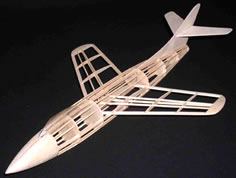
- Adam Jenik
|
|||
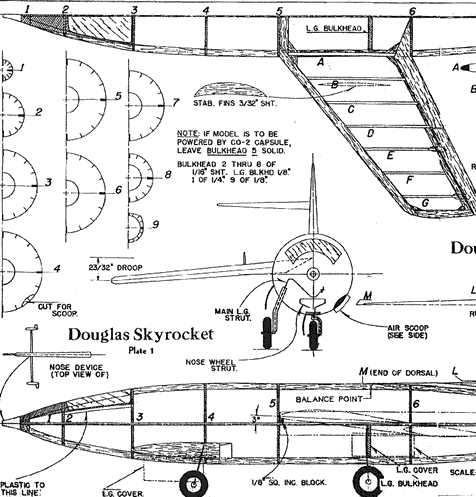 |
|
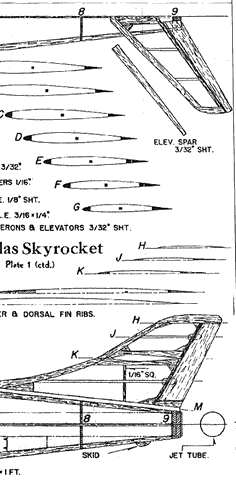 |
|
|
|
|
|
|
|
|
Acknowledgements - Article: Roger Simmonds - Illustrations: Roger Simmonds, Steve Bage, André Bird, Allen Hunt, Adam Jenik, MAAC archives via Bill Henderson, Mike Ingram, Peter Tolhurst |
|
|
|
|
ABOUT | MOTORS | MODELS | ARCHIVE | HISTORY | STORE | FAQ | LINKS |
|
|
Terms of Use
|
Queries? Corrections? Additions?
Please
contact us.
|
|